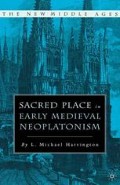Abstract
The Platonic identification of unity and goodness means that unity of some sort will be a goal in any Platonic philosophical system. But not everything is capable of the same degree of unity. The Neoplatonists are traditionally distinguished from other Platonists by their claim that perfect unity must be beyond being, since all being involves some sort of multiplicity. They give the personal name of “One” to this perfect unity which, since it is prior to all multiplicity, must be regarded in some sense as the cause of all multiplicity. Between the unity of the One and the multiplicity of our world lies the divine intellect, the “One-and-Many.” In the divine intellect, the forms of things are distinct from one another, but each form has all the other forms within it. The form of an oak tree, for instance, is distinct from the form of a rose bush, but it has the form of the rose bush within it, and vice versa. If we could think at the level of the divine intellect, we would remain ourselves, but in ourselves we would be one with all other things and with the gods. Presendy, however, our thought is conditioned by the bodies we inhabit, and bodies can only exist in places, which ensure one kind of unity while prohibiting another. Place holds together in a unity whatever it contains, but it isolates its contents from all other things. A garden, as a place, holds together all the plants that it contains, but it keeps those plants from being one with anything outside the garden.
Access this chapter
Tax calculation will be finalised at checkout
Purchases are for personal use only
Preview
Unable to display preview. Download preview PDF.
Notes
R. Sorabji, Matter, Space, and Motion: Theories in Antiquity and Their Sequel (Ithaca, New York: Cornell University Press, 1988).
L. Siorvanes, Proclus: Neo-Platonic Philosophy and Science (New Haven and London: Yale University Press, 1996), pp. 133–36, 247–56.
H.D. Saffrey, “Les Néoplatoniciens et les oracles chaldaiques,” in Revue des Études Augustiniennes, 27 (1981), pp. 209–25.
M. Edwards, Neoplatonic Saints: the Lives of Plotinus and Proclus by their Students (Liverpool: Liverpool University Press, 2000), p. 21, n. 115.
C. Steel, The Changing Self: a Study on the Soul in Later Neoplatonism (Académie voor Wetenschappen, Letteren en Schone Kunsten: Brussels, 1978), p. 33.
Copyright information
© 2004 Michael L. Harrington
About this chapter
Cite this chapter
Harrington, L.M. (2004). The Neoplatonic Background. In: Sacred Place in Early Medieval Neoplatonism. The New Middle Ages. Palgrave Macmillan, New York. https://doi.org/10.1007/978-1-137-09193-2_3
Download citation
DOI: https://doi.org/10.1007/978-1-137-09193-2_3
Publisher Name: Palgrave Macmillan, New York
Print ISBN: 978-1-349-73306-4
Online ISBN: 978-1-137-09193-2
eBook Packages: Palgrave Literature & Performing Arts CollectionLiterature, Cultural and Media Studies (R0)

